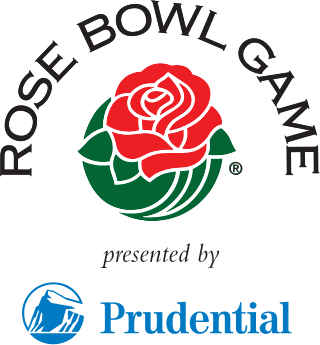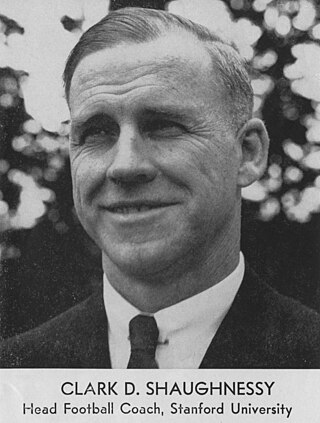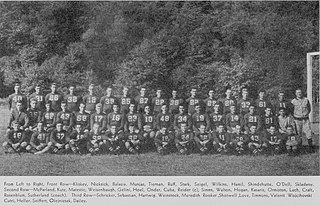Related Research Articles

The Rose Bowl Game is an annual American college football bowl game, traditionally played on January 1 at the Rose Bowl in Pasadena, California. When New Year's Day falls on a Sunday, the game is played on Monday, January 2. Nicknamed "The Granddaddy of Them All" by broadcaster Keith Jackson, it was the first postseason football game ever established. The Rose Bowl Game was first played in 1902 as the Tournament East–West football game, and has been played annually since 1916. Since 1945, it has been the highest attended college football bowl game. The game is a part of the Pasadena Tournament of Roses Association's "America's New Year Celebration", which also includes the historic Rose Parade. Winners of the game receive the Leishman Trophy, named for former Tournament of Roses presidents, William L. Leishman and Lathrop K. Leishman who played an important part in the history of this game.

The Stanford Cardinal football program represents Stanford University in college football at the NCAA Division I FBS level and is a member of the Atlantic Coast Conference. The program was previously in the Pac-12 Conference. The team is known as the Cardinal, adopted prior to the 1982 season. Stanford was known as the "Cardinal" for its first two decades of athletic competition, then more commonly as the "Cardinals" until 1930. The name was changed to the "Indians" from 1930 to January 1972, and back to the "Cardinals" from 1972 through 1981. A student vote in December 1975 to change the nickname to "Robber Barons" was not approved by administrators.

The 1927 college football season ended with the Illini of the University of Illinois (7–0–1) being recognized as champion under the Dickinson System. At season's end, the Rissler Cup was awarded to the team that finished first in the "Dickinson ratings", which considered strength of schedule, in that a win, loss or tie against a "strong" opponent was worth more than one against a lesser team, and the results were averaged.
The 1931 college football season saw the USC Trojans win the Knute Rockne Memorial Trophy as national champion under the Dickinson System, as well as the No. 1 position from each of the other three contemporary major selectors. Rockne, who had coached Notre Dame to a championship in 1930, had been killed in a plane crash on March 31, 1931. For the first time, the champion under the Dickinson System also played in a postseason game. The 1932 Rose Bowl, promoted as a national championship game between the best teams of East and West, matched USC and Tulane, No. 1 and No. 2 in the Dickinson ratings. USC won, 21–12, and was awarded the Albert Russel Erskine Trophy.

The 1923 Rose Bowl, played on January 1, 1923, was an American Football bowl game. It was the 9th Rose Bowl Game. The USC Trojans defeated the Penn State Nittany Lions 14–3. Leo Calland, a USC guard, was named the Rose Bowl Player of the Game when the award was created in 1953 and selections were made retroactively. It was the first bowl game appearance for both the University of Southern California and Pennsylvania State University football teams. It was also the first Tournament of Roses football game held in the newly constructed Rose Bowl Stadium, although other games had been played in it prior to this one.

The 1940 Stanford Indians football team, nicknamed the "Wow Boys", represented Stanford University as a member of the Pacific Coast Conference (PCC) during the 1940 college football season. First-year head coach Clark Shaughnessy inherited a team that finished with a 1–7–1 record the previous season. He installed his own version of the T formation, a system that had largely fallen into disuse since the 1890s and was viewed as obsolete. The Indians shocked observers when they won all ten of their games including the Rose Bowl, which prompted several selectors to declare them the 1940 national champions. Stanford's dramatic reversal of fortunes prompted football programs across the nation to abandon the single-wing formation in favor of the newly reminted T formation.
The 1928 Rose Bowl Game was a match between Stanford (7–2–1) and the Pittsburgh Panthers (8–0–1). Usually, the Rose Bowl was played on January 1, but in 1928, that fell on a Sunday, so the game was played on January 2, 1928. At this time, the Rose Bowl was the top and only bowl game, an east-vs.-west matchup. Stanford won the game, 7–6.

The 1926 Stanford Indians football team was an American football team that represented Stanford University in the Pacific Coast Conference (PCC) during the 1926 college football season. In head coach Pop Warner's third season at Stanford, the team compiled a 10–0 record during the regular season, outscored its opponents by a total of 261 to 66, and won the PCC championship. Stanford then faced undefeated Alabama in the 1927 Rose Bowl, which ended in a 7–7 tie.

The 1941 Stanford Indians football team represented Stanford University as a member of the Pacific Coast Conference (PCC) during the 1941 college football season. Second-year head coach Clark Shaughnessy led the team to a 6–3 record. Before the season, Stanford, which the year prior had finished 10–0, was considered a favorite for the national championship, but three conference losses put it out of contention for a return to the Rose Bowl. After the season, Shaughnessy left Stanford to take over as head coach at the University of Maryland.

The 1933 Stanford Indians football team represented Stanford University as a member of the Pacific Coast Conference (PCC) during the 1933 college football season. Led by first-year head coach Tiny Thornhill, the Indians compiled an overall record of 8–2–1 with a mark of 4–1 in conference play, sharing the PCC title with Oregon. Stanford was invited to the Rose Bowl, where Indians lost to Columbia. The team played home games at Stanford Stadium in Stanford, California.
The 1980 Stanford Cardinals football team represented Stanford University in the Pacific-10 Conference during the 1980 NCAA Division I-A football season. Following the surprise resignation of Rod Dowhower after one season in January, Stanford's new head coach was alumnus Paul Wiggin, and he led the Cardinals to a 6–5 record. Home games were played on campus at Stanford Stadium in Stanford, California.
The 1924 Stanford football team represented Stanford University as a member of the Pacific Coast Conference (PCC) during 1924 college football season. Led by first-year head coach was Pop Warner, Stanford compiled an overall record of 7–1–1 with a mark of 3–0–1 in conference play, winning the program's first PCC title as co-champions with California. Stanford made its second bowl game appearance, losing to Notre Dame in the Rose Bowl.
The 1928 Stanford football team represented Stanford University in the 1928 college football season. Under fifth-year head coach Pop Warner, Stanford played its home games on campus at Stanford Stadium and were members of the Pacific Coast Conference. The team was ranked No. 4 in the nation in the Dickinson System ratings released in December 1928.
The 1932 Stanford Indians football team was an American football team that represented Stanford University in the Pacific Coast Conference (PCC) during the 1932 college football season. In its ninth and final season under head coach Pop Warner, the team compiled a 6–4–1 record, finished in seventh place in the PCC, and outscored opponents by a total of 171 to 58.
The 1921 Stanford football team represented Stanford University in the 1921 college football season. They were coached by Eugene Van Gent in his only season as head coach. The team played most of its home games at the 15,000-seat Stanford Field while construction on the new 60,000-seat Stanford Stadium was being completed. Stanford Stadium officially opened for the final game, the Big Game against California, in which the Bears defeated Stanford 42–7.
The 1927 Idaho Vandals football team represented the University of Idaho in the 1927 college football season. The Vandals were led by second-year head coach Charles F. Erb and were members of the Pacific Coast Conference. Home games were played on campus in Moscow at MacLean Field.

The 1927 Pittsburgh Panthers football team was an American football team that represented the University of Pittsburgh as an independent during the 1927 college football season. In its fourth season under head coach Jock Sutherland, the team compiled an 8–1–1 record, shut out seven of its ten opponents, suffered it sole loss to Stanford by a 7–6 score in the 1928 Rose Bowl, and outscored all opponents by a total of 285 to 27. The team played its eight home games at Pitt Stadium in Pittsburgh. Pitt sports fans were treated to a superb 1927-28 athletic program as four Panther teams finished their seasons undefeated - football, basketball, track and swimming. The team was ranked No. 2 in the nation in the Dickinson System ratings released in December 1927.

The 1932 Pittsburgh Panthers football team was an American football team that represented the University of Pittsburgh as an independent during the 1932 college football season. In its ninth season under head coach Jock Sutherland, the team compiled an 8–1–2 record, shut out eight of its eleven opponents, suffered its sole loss to USC in the 1933 Rose Bowl, and outscored all opponents by a total of 182 to 60. The team played its home games at Pitt Stadium in Pittsburgh.

The 1927 Oregon State Aggies football team represented Oregon State University in the Pacific Coast Conference (PCC) during the 1927 college football season. In their fourth season under head coach Paul J. Schissler, the Aggies compiled a 3–3–1 record and outscored their opponents 98 to 78. Under coach Schissler, from 1925 to 1932, no team captains were elected. The team played its home games on campus at Bell Field in Corvallis, Oregon.
The 1925 Pacific Coast Conference football season was the 11th season of college football played by the member schools of the Pacific Coast Conference (PCC) and was a part of the 1925 college football season.
References
- ↑ William Leiser (October 2, 1927). "Saints Down Cards, 16-0: Bettencourt, Hicks Make Touchdowns for Madigan". The San Francisco Examiner. p. 31 – via Newspapers.com.
- ↑ George Bertz, "Big Stanford Cards Smash Aggies, 20–6: Pop Warner's Shifty Team Tears Great Holes Through Beaver Line; Outplays Opponents in Contest Replete with Thrills," Oregon Sunday Journal, Oct. 23, 1927, pp. XX, 4.
- ↑ Porter Yett, "Speed and Shiftiness of Stanford Ball Carriers Entrall Crowds at the Stadium: Play-by-Play Description of Stanford–Aggie Battle," The Oregonian, Oct. 23, 1927, section 6, pp. 1-2.
- ↑ "Cardinals take Oregon Aggies by 20–6 score". The Fresno Bee. October 23, 1926. Retrieved October 21, 2022– via Newspapers.com.
- ↑ "Oregon drops hard-fought game to Stanford, 19 to 0". Eugene Guard. Oregon. October 29, 1927. p. 1.
- ↑ A.K. (November 7, 1927). "Olympic Club Beats Broncos, 6-0: Kutsch Makes Lone Tally in Third Period". The San Francisco Examiner. pp. 1P, 3P – via Newspapers.com.
- ↑ The Los Angeles Times estimated the crowd at 58,000. The Pasadena Evening Post indicates the attendance was "over 70,000."
- ↑ "Cards Win For West: Pitt Vanquished By 7-6 Score". Los Angeles Times. January 3, 1928. p. 1.
- ↑ "Cards, Pitt in Rose Bowl Grid Classic". Pasadena Evening Post. January 2, 1928. p. 1.
- ↑ "Stanford Game-by-Game Results; 1927–1931". College Football Data Warehouse. Archived from the original on October 4, 2013. Retrieved September 13, 2013.